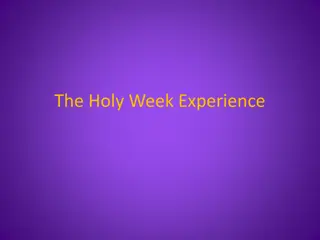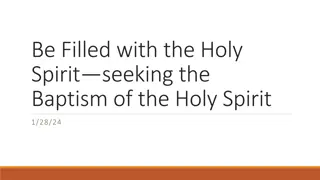Understanding the Elevation of the Holy Cross Feast
The Elevation of the Holy Cross, celebrated on September 14, commemorates the finding and recovery of the Cross. Learn about Empress Helen's devotion and the significance of the Cross as a Christian symbol. Dive into historical events and the enduring impact of Constantine and his mother in this lesson.
- Elevation of the Holy Cross
- Christian symbolism
- Empress Helen
- Constantine the Great
- Byzantine history
Download Presentation

Please find below an Image/Link to download the presentation.
The content on the website is provided AS IS for your information and personal use only. It may not be sold, licensed, or shared on other websites without obtaining consent from the author. Download presentation by click this link. If you encounter any issues during the download, it is possible that the publisher has removed the file from their server.
E N D
Presentation Transcript
13 Sep 2020 Lesson plan 13 Sep 2020 Lesson plan 01 Elevation of the Holy Cross Elevation of the Holy Cross 01 Before class: Streaming test, mute personnel, Check off sheet, Training Aids, Bible, Orthodox Cross, Teaching books, test question to class middle of lesson Introduction: Teaching process Sign on & into CHAT with full name Communications CHAT first, Voice second, Keep voice muted Keep mute on, hit and hold down space bar to talk & release when finished Type questions into CHAT, answers will be immediate or followed up before end of class Only have about 20 minutes, so most so keep voice to minimum Next lesson will be 0900 Sunday 20 Sep, Invitations will be sent out NLT Friday before class via email & Txt Test recording the lesson with an eye to post it for anyone who missed the lesson
Opening Prayer Opening Prayer (P2) In the name of the Father, and the Son, and the Holy Spirit. May the Lord Bless us and keep us. May He shine His light in our hearts. May He be merciful to us and grant us peace. Amen.
Objectives Objectives (P3) Recount events surrounding the The Elevation of the Holy Cross Explain the significance of basil in the service Describe the cross as a Christian symbol Know the date of the feast day
Elevation of the Cross (also referred to as the Exaltation of the Cross): (P4) The feast of the Elevation of the Holy Cross is celebrated on September 14 and commemorates 2 things: The finding of the Cross by the Empress Helen, and, Recovery of the Cross from the Persians in 630 AD (discovery and the recovery) The two timbers on which the Messiah died to save the world, priceless beyond measure, form the most familiar and beloved symbol in a world full of symbols and emblems. For nearly three hundred years after his death the Cross was buried in obscurity, eventually to be salvaged through the efforts of a devout Byzantine emperor and his mother. The Emperor Constantine the Great was not only the first Christian emperor, but, together with his mother, has been honored with sainthood. His mother is honored for her determined efforts in the cause of Christianity. It was Constantine who beheld a vision in the sky in which were emblazoned the words 'en touto Nika', translating into "In this Sign Conquer," etched across a brilliant cross of Jesus Christ. Ordering that all the shields of his army bear the sign of the Cross, Constantine went on to subdue the enemies of the state and to establish the Christian faith, which has outlived his empire and will endure forever. Helen, the mother of Constantine and a saint of the Church, had the full support of her son when she decided to recover the cross of Christ, and although nearly three hundred years had elapsed since the Crucifixion, she was optimistic in her resolve to find the Cross and return it to the city of Constantinople. After months of diligent search, painstakingly following every historic clue as to its whereabouts, Helen and her dedicated group of searchers discovered the Cross on 14 September 325 AD in the vicinity of Golgotha, where it had been buried in the dust of the centuries.
1) Finding of the Cross (Discovery) by the Empress Helen (the mother of St. Constantine the Great) on Golgotha in 326 AD, the place where Christ was crucified (P5) On the spot where the Cross was discovered, St. Helen had found a hitherto unknown flower of rare beauty and fragrance, which has been named "Vasiliko," or Basil, meaning the flower of royalty. Note that the word "Vasiliko" means "of the King," since the word "Basileus" in Greek means "King"; so, the plant Vasiliko, Basil, is tied to the Precious Cross of the King of Glory, our Lord Jesus Christ. Underneath the Basil, the Cross of Christ was found, but with it were the other two crosses, those used to crucify the two thieves on either side of Christ. The sign with the inscription, "Jesus of Nazareth, the King of the Jews", also lay among the three crosses. In order to determine which one was the true cross, a sick woman was told to kiss each of the three crosses. The woman kissed the first cross with no result. She kissed the second cross and again nothing happened. However, when the ailing woman kissed the True Cross, she was immediately made well. It so happened that a funeral procession was passing that way, and so the body of the dead man was placed on each of the crosses, and when it was placed on the True Cross, the dead man came to life thus the name the Life-Giving Cross, which gives life not only to that man, but to each person who believes in the sacrifice of Christ on the Cross and His all-glorious three day Resurrection. When the true Cross was identified, it was lifted on high for all the people to see, who then continually sang Kyrie eleison, a practice which is still enacted at current celebrations of this feast.
2) Recovery of the Cross on which Jesus Christ was crucified from the Persians (P6) For three hundred years the Cross stayed in the possession of the Christians in Jerusalem, but after a series of forays the city of Jerusalem was captured by the Persians in 614 AD and the Cross fell into the hands of an enemy that for years prior and since has scoffed at the faith of Jesus Christ. Several attempts were made by devout and bold Christians to recover the precious Cross, but they were no match for the Persian hordes. Finally, the Byzantine Emperor Heraklios, in the tradition of his ancestor Constantine, amassed an army of size and equipment to match that of the Persians, and after months of planning, launched an attack on the Holy City - but with no immediate success. What the Persians lacked in faith they made up for in numbers of trained warriors who respected nothing but the sword, and because of this relentless defence the tide of battle wavered over an agonizing fifteen years until at last the Christian forces broke through the Persian defenses and regained control of the Holy City and its priceless treasure. The successful outcome of the campaign is celebrated jointly with the finding of the Cross by St. Helen on September 14, and the veneration of the Precious and Life-giving Cross is again celebrated by Christians on the Third Sunday of Lent.
During the Divine Liturgy, the Cross is carried in a procession born aloft on a tray of flowers, while in some traditions it is the herb Basil which surrounds the Cross on a tray. At the end of the service, the blessed flowers, or the sprigs of Basil are distributed to the faithful. According to tradition, St. Helen discovered the Cross buried in a spot which Basil had grown and many had known miracles occurring through contact with the Cross. Basil extract has even been shown to help in inhibiting resistant strains of bacteria that are unable to respond to antibiotics. This Great Feast is, contrary to the notion of being a feast day, actually a day of strict fasting for the Orthodox (no food for those who physically can abstain) until sundown. Different churches, depending on their schedules, mark it slightly differently some with a vesperal Liturgy the night before (the Orthodox liturgical day actually runs from sundown to sundown, and thus begins at sundown on the 13th), some with a morning liturgy on the calendar day itself (and often this may depend on the day of the week if the Feast is already on a Sunday, for instance). When we elevate the Cross and bow down before it (Cross) in veneration and worship to God, we proclaim that we belong to the Kingdom not of this world, and that our only true and enduring citizenship is with the saints in the city of God (Eph 2.19; Heb 11.10; Rev 21 22)
Meaning of Cross (P8) https://youtu.be/MaQO0gMu7w8 (4 min video)
Objectives Objectives (P9) Recount events surrounding the The Elevation of the Holy Cross Explain the significance of basil in the service Describe the cross as a Christian symbol Know the date of the feast day
Review & Closing Prayer(P10) In the name of the Father, and the Son, and the Holy Spirit. May the Lord Bless us and keep us. May He shine His light in our hearts. May He be merciful to us and grant us peace. Amen.























